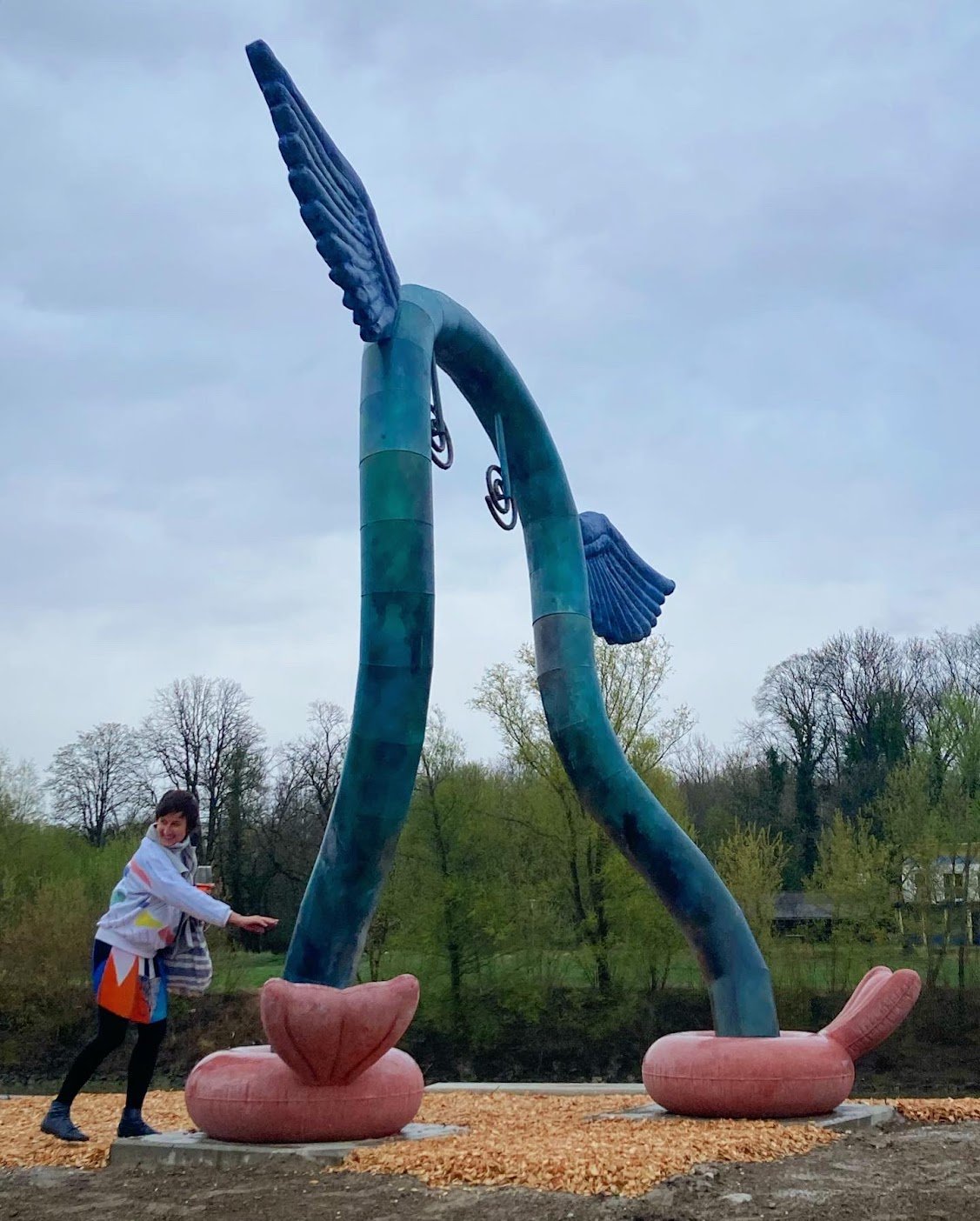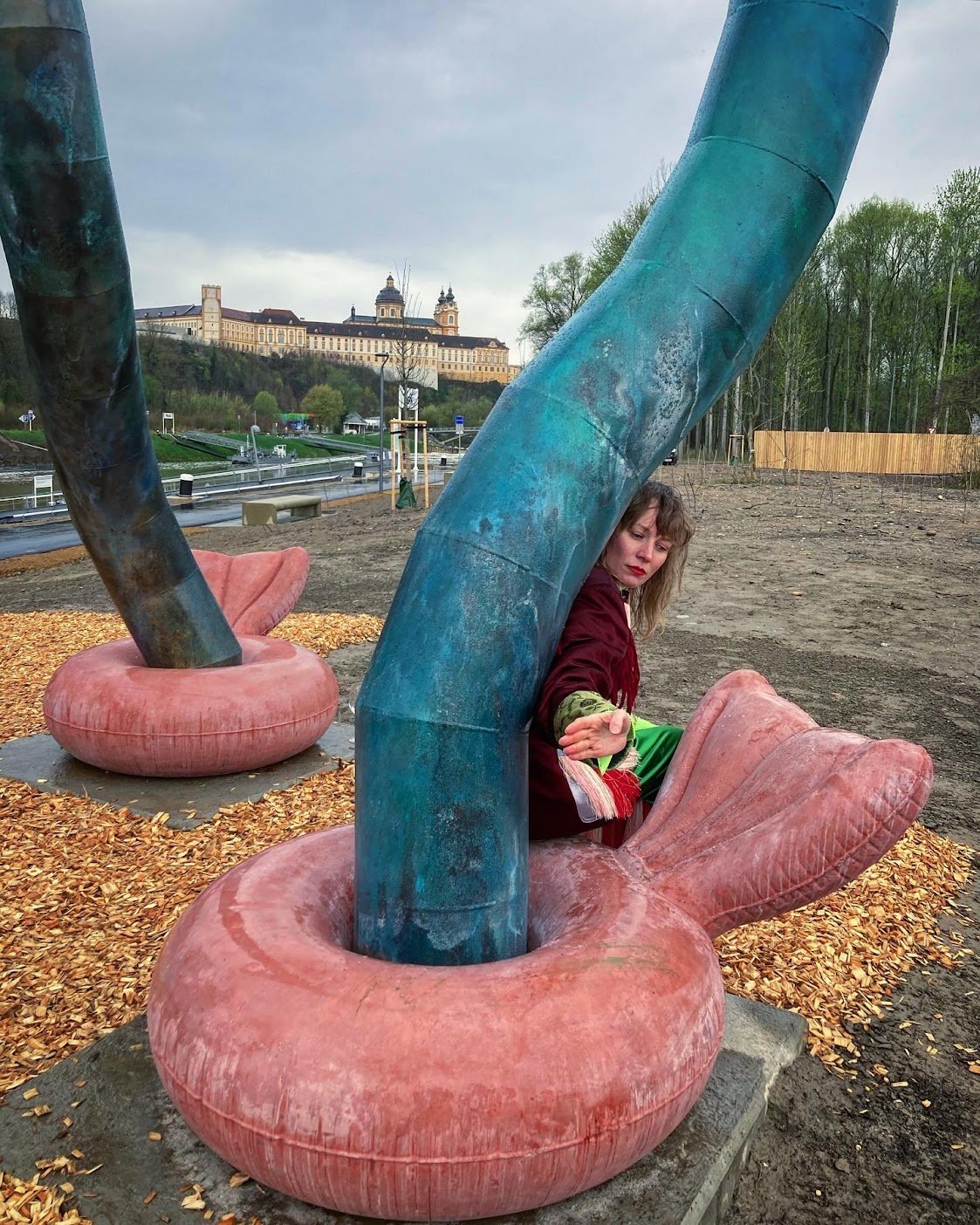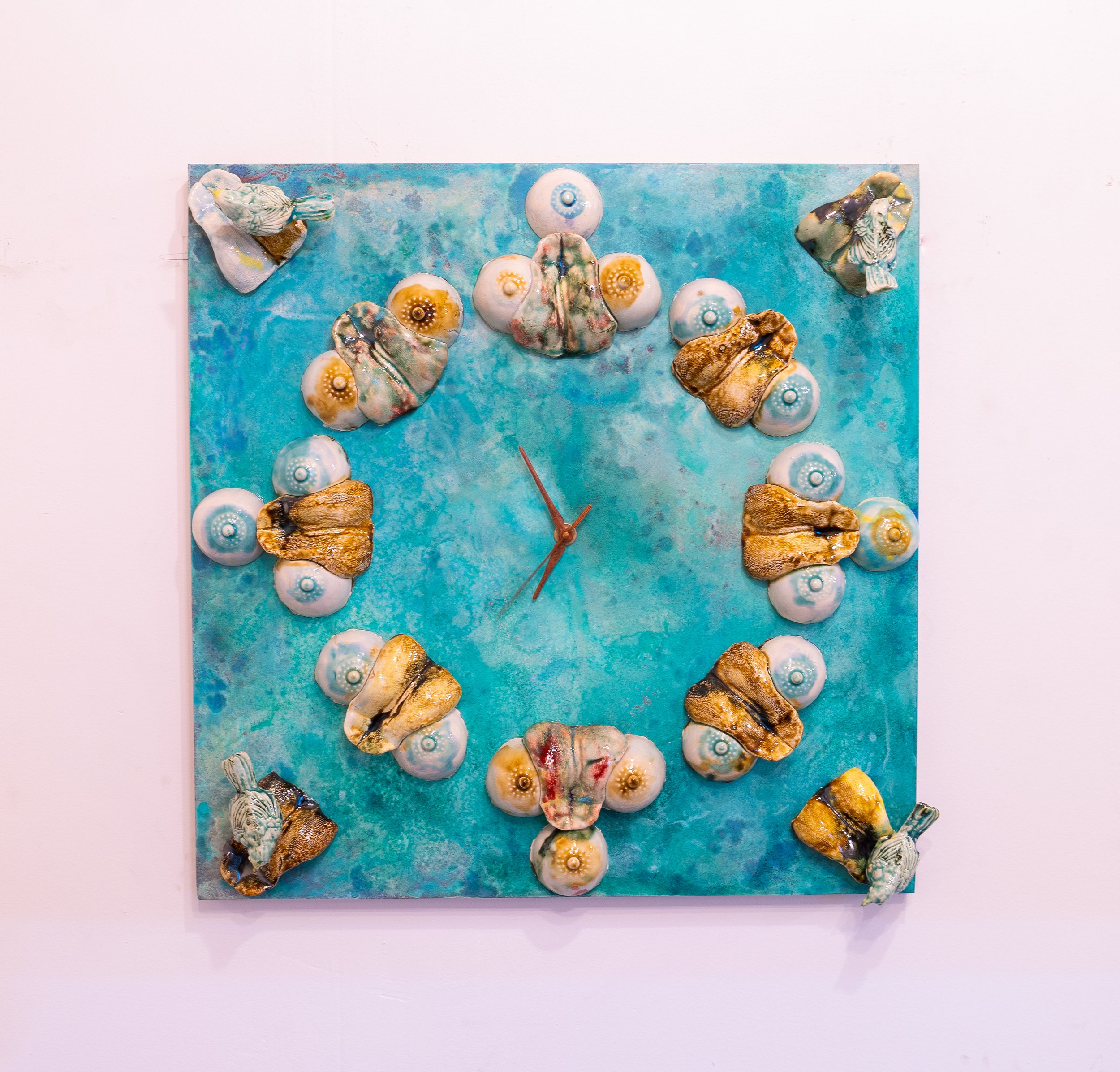
Kris Lemsalu’s public sculpture “Doora” installed in Melk, Austria.
Verdigris patina on bronze plated steel, with cast concrete wings and feet.

Kris Lemsalu’s public sculpture “Doora” installed in Melk, Austria.
Verdigris patina on bronze plated steel, with cast concrete wings and feet.

Kris Lemsalu’s public sculpture “Doora” installed in Melk, Austria.
Verdigris patina on bronze plated steel, with cast concrete wings and feet.

Kris Lemsalu’s public sculpture “Doora” installed in Melk, Austria.
Verdigris patina on bronze plated steel, with cast concrete wings and feet.

Kris Lemsalu x Teruko Kushi
Copper oxidized and heat treated steel, porcelain, aluminum and bronze clock hardware. 30”x30”x2” 2023
Press Release:
The collaboration between Kris Lemsalu and Teruko Kushi is a captivating fusion of artistic expression, where the enigmatic qualities of time fuse with the beauty and the grotesque of the feminine form. Through their series of steel, bronze and porcelain wall hanging clocks, Lemsalu and Kushi create a symbolic visual dialog merging human, animal, organic and mechanic signifiers. Lemsalu contributes her signature blend of delicate ceramics, textiles, and elements of the natural world, while Kushi’s expertise in metallurgy and patinas becomes transformative with unconventional surface treatments. Transcending individual artistic expression, this material interplay evokes an uncanny and unruly timekeeping practice itself, symbolizing feminine experience and the collective power in the eternal dance of time.
The clock itself evokes a kind of management over the body. Linked to industrialization and the fungibility of minutes in the productive work day, its current dominant social significance is that of monitoring movement, constraining the physiological under a certain rhythm of labor and output. Credited to Frederick Winslow Taylor in the early 1900’s, maximizing the worker’s productivity in the factory became synonymous with the definition of progress, and the clock became a tool of measurement and data more than a tool of locating one’s self in the space of a day. Countering this narrative and refusing a totalizing definition of the body within time, Lemsalu and Kushi’s collaboration reveals a multiplicity of temporal experiences, and even suggests that time keeping as a practice is one of contact between the many symbol orders they evoke.
For instance, Lemsalu’s ceramic tongues and breasts take the expected place of numbers in both Aster, Maru, and Inna. Reproduction is suggested as a time keeper in this playful switch, where the sensuous image evokes a bodily narrative as time is passed through feeling and play — each touch different than the last— in place of the hegemony of segmented hours. The presence of reproductive organs here have a deeper critique to them as well. When super imposed over the western history of labor and clock management, the evoke what Sylvia Frederici has called in Wages for Housework, the “significance in demystifying and subverting the role to which women have been confined”, critiquing our assumptions about a laboring body by problematizing the presumed objectivity of time.
Kushi’s treatment of transformation furthers this play. Through altering the material surface of the clocks through patinas and a combination of metals, times passing visually reflects notions of deep time in the ecological or geological sense. Against the incomprehensibly long scope of Earth’s temporality — 4.5 billion years — the use of the materials appears to dismantle the hands of the clock-face, ticking away to mark mere hours and days, reminding us that the common clock has been in existence for only roughly 500 years. Flipped in hierarchy, the clock here plays support to the remarkable natural world’s greater temporal orders.

Kris Lemsalu x Teruko Kushi
Copper plated steel, verdigris patina, porcelain, aluminum and bronze clock hardware.

INNA
Kris Lemsalu x Teruko Kushi
Red oxide patinated steel, porcelain, bronze and aluminum clock hardware.

Kris Lemsalu x Teruko Kushi
Wall Hanging Clock
Porcelain, patinated bronze, steel, tigers eye, glass, mica dust, silicone, internal battery operated clock. 2022








Kris Lemsalu’s public sculpture “Doora” installed in Melk, Austria.
Verdigris patina on bronze plated steel, with cast concrete wings and feet.
Kris Lemsalu’s public sculpture “Doora” installed in Melk, Austria.
Verdigris patina on bronze plated steel, with cast concrete wings and feet.
Kris Lemsalu’s public sculpture “Doora” installed in Melk, Austria.
Verdigris patina on bronze plated steel, with cast concrete wings and feet.
Kris Lemsalu’s public sculpture “Doora” installed in Melk, Austria.
Verdigris patina on bronze plated steel, with cast concrete wings and feet.
Kris Lemsalu x Teruko Kushi
Copper oxidized and heat treated steel, porcelain, aluminum and bronze clock hardware. 30”x30”x2” 2023
Press Release:
The collaboration between Kris Lemsalu and Teruko Kushi is a captivating fusion of artistic expression, where the enigmatic qualities of time fuse with the beauty and the grotesque of the feminine form. Through their series of steel, bronze and porcelain wall hanging clocks, Lemsalu and Kushi create a symbolic visual dialog merging human, animal, organic and mechanic signifiers. Lemsalu contributes her signature blend of delicate ceramics, textiles, and elements of the natural world, while Kushi’s expertise in metallurgy and patinas becomes transformative with unconventional surface treatments. Transcending individual artistic expression, this material interplay evokes an uncanny and unruly timekeeping practice itself, symbolizing feminine experience and the collective power in the eternal dance of time.
The clock itself evokes a kind of management over the body. Linked to industrialization and the fungibility of minutes in the productive work day, its current dominant social significance is that of monitoring movement, constraining the physiological under a certain rhythm of labor and output. Credited to Frederick Winslow Taylor in the early 1900’s, maximizing the worker’s productivity in the factory became synonymous with the definition of progress, and the clock became a tool of measurement and data more than a tool of locating one’s self in the space of a day. Countering this narrative and refusing a totalizing definition of the body within time, Lemsalu and Kushi’s collaboration reveals a multiplicity of temporal experiences, and even suggests that time keeping as a practice is one of contact between the many symbol orders they evoke.
For instance, Lemsalu’s ceramic tongues and breasts take the expected place of numbers in both Aster, Maru, and Inna. Reproduction is suggested as a time keeper in this playful switch, where the sensuous image evokes a bodily narrative as time is passed through feeling and play — each touch different than the last— in place of the hegemony of segmented hours. The presence of reproductive organs here have a deeper critique to them as well. When super imposed over the western history of labor and clock management, the evoke what Sylvia Frederici has called in Wages for Housework, the “significance in demystifying and subverting the role to which women have been confined”, critiquing our assumptions about a laboring body by problematizing the presumed objectivity of time.
Kushi’s treatment of transformation furthers this play. Through altering the material surface of the clocks through patinas and a combination of metals, times passing visually reflects notions of deep time in the ecological or geological sense. Against the incomprehensibly long scope of Earth’s temporality — 4.5 billion years — the use of the materials appears to dismantle the hands of the clock-face, ticking away to mark mere hours and days, reminding us that the common clock has been in existence for only roughly 500 years. Flipped in hierarchy, the clock here plays support to the remarkable natural world’s greater temporal orders.
Kris Lemsalu x Teruko Kushi
Copper plated steel, verdigris patina, porcelain, aluminum and bronze clock hardware.
INNA
Kris Lemsalu x Teruko Kushi
Red oxide patinated steel, porcelain, bronze and aluminum clock hardware.
Kris Lemsalu x Teruko Kushi
Wall Hanging Clock
Porcelain, patinated bronze, steel, tigers eye, glass, mica dust, silicone, internal battery operated clock. 2022